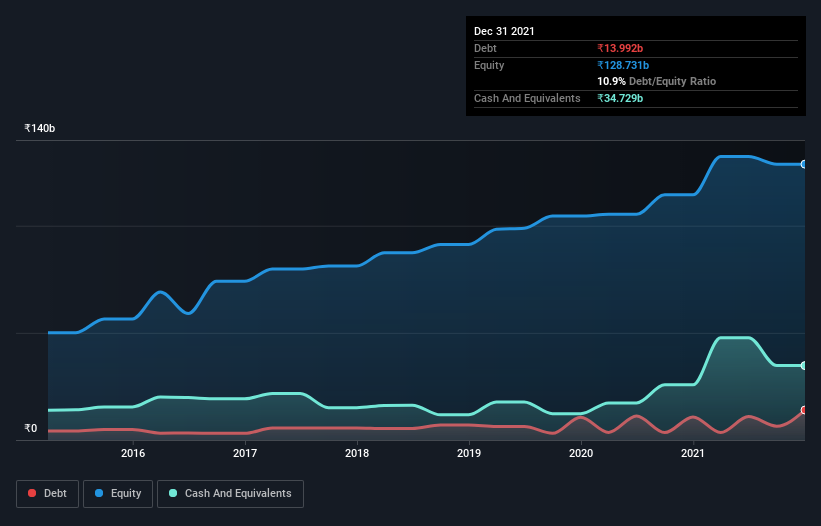Stock Analysis
Does Asian Paints (NSE:ASIANPAINT) Have A Healthy Balance Sheet?

The external fund manager backed by Berkshire Hathaway's Charlie Munger, Li Lu, makes no bones about it when he says 'The biggest investment risk is not the volatility of prices, but whether you will suffer a permanent loss of capital.' It's only natural to consider a company's balance sheet when you examine how risky it is, since debt is often involved when a business collapses. We can see that Asian Paints Limited ( NSE:ASIANPAINT ) does use debt in its business. But is this debt a concern to shareholders?
What Risk Does Debt Bring?
Generally speaking, debt only becomes a real problem when a company can't easily pay it off, either by raising capital or with its own cash flow. Part and parcel of capitalism is the process of 'creative destruction' where failed businesses are mercilessly liquidated by their bankers. However, a more frequent (but still costly) occurrence is where a company must issue shares at bargain-basement prices, permanently diluting shareholders, just to shore up its balance sheet. By replacing dilution, though, debt can be an extremely good tool for businesses that need capital to invest in growth at high rates of return. When we examine debt levels, we first consider both cash and debt levels, together.
Check out our latest analysis for Asian Paints
How Much Debt Does Asian Paints Carry?
As you can see below, at the end of December 2021, Asian Paints had ₹14.0b of debt, up from ₹10.8b a year ago. Click the image for more detail. But on the other hand it also has ₹34.7b in cash, leading to a ₹20.7b net cash position.

How Healthy Is Asian Paints' Balance Sheet?
Zooming in on the latest balance sheet data, we can see that Asian Paints had liabilities of ₹69.5b due within 12 months and liabilities of ₹12.3b due beyond that. Offsetting this, it had ₹34.7b in cash and ₹31.0b in receivables that were due within 12 months. So its liabilities total ₹16.2b more than the combination of its cash and short-term receivables.
Having regard to Asian Paints' size, it seems that its liquid assets are well balanced with its total liabilities. So it's very unlikely that the ₹2.89t company is short on cash, but still worth keeping an eye on the balance sheet. While it does have liabilities worth noting, Asian Paints also has more cash than debt, so we're pretty confident it can manage its debt safely.
The good news is that Asian Paints has increased its EBIT by 6.3% over twelve months, which should ease any concerns about debt repayment. There's no doubt that we learn most about debt from the balance sheet. But ultimately the future profitability of the business will decide if Asian Paints can strengthen its balance sheet over time. So if you want to see what the professionals think, you might find this free report on analyst profit forecasts to be interesting.
Finally, a business needs free cash flow to pay off debt; accounting profits just don't cut it. While Asian Paints has net cash on its balance sheet, it's still worth taking a look at its ability to convert earnings before interest and tax (EBIT) to free cash flow, to help us understand how quickly it is building (or eroding) that cash balance. During the last three years, Asian Paints produced sturdy free cash flow equating to 61% of its EBIT, about what we'd expect. This cold hard cash means it can reduce its debt when it wants to.
Summing up
While it is always sensible to look at a company's total liabilities, it is very reassuring that Asian Paints has ₹20.7b in net cash. So we don't think Asian Paints's use of debt is risky. There's no doubt that we learn most about debt from the balance sheet. But ultimately, every company can contain risks that exist outside of the balance sheet. For example, we've discovered 1 warning sign for Asian Paints that you should be aware of before investing here.
At the end of the day, it's often better to focus on companies that are free from net debt. You can access our special list of such companies (all with a track record of profit growth). It's free.
Valuation is complex, but we're helping make it simple.
Find out whether Asian Paints is potentially over or undervalued by checking out our comprehensive analysis, which includes fair value estimates, risks and warnings, dividends, insider transactions and financial health.
View the Free AnalysisHave feedback on this article? Concerned about the content? Get in touch with us directly. Alternatively, email editorial-team (at) simplywallst.com.
This article by Simply Wall St is general in nature. We provide commentary based on historical data and analyst forecasts only using an unbiased methodology and our articles are not intended to be financial advice. It does not constitute a recommendation to buy or sell any stock, and does not take account of your objectives, or your financial situation. We aim to bring you long-term focused analysis driven by fundamental data. Note that our analysis may not factor in the latest price-sensitive company announcements or qualitative material. Simply Wall St has no position in any stocks mentioned.
About NSEI:ASIANPAINT
Asian Paints
Engages in the manufacturing, selling, and distribution of paints, coatings, and products related to home decoration and bath fittings in Asia, the Middle East, Africa, and the South Pacific region.
Outstanding track record with flawless balance sheet and pays a dividend.

